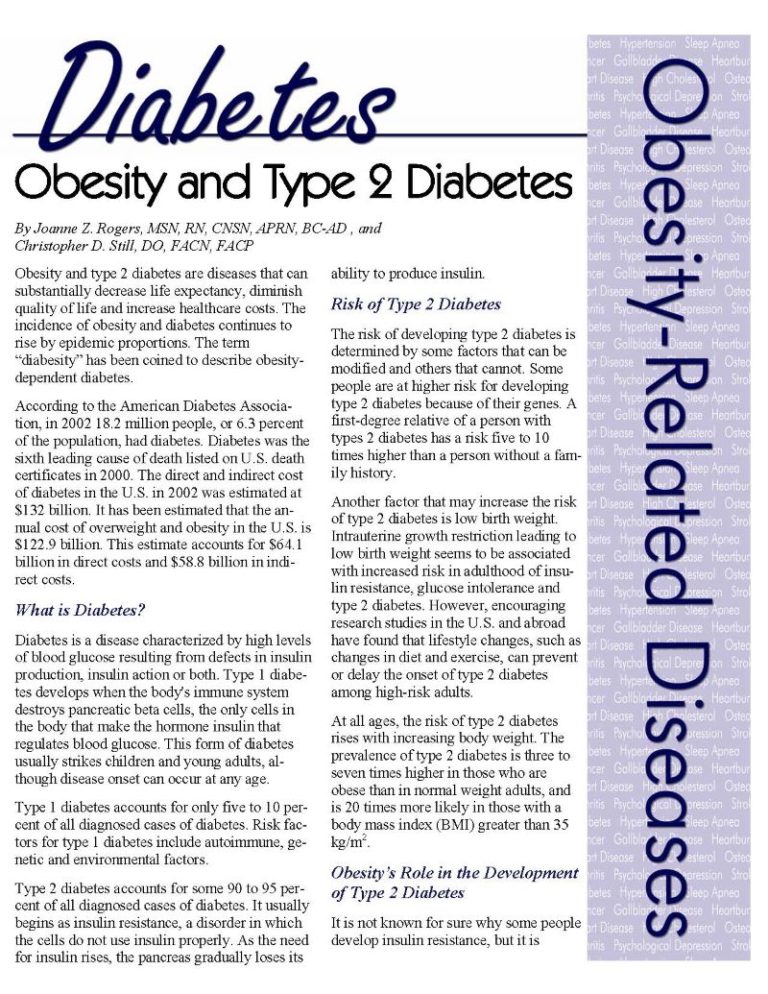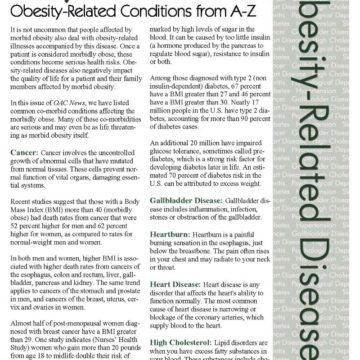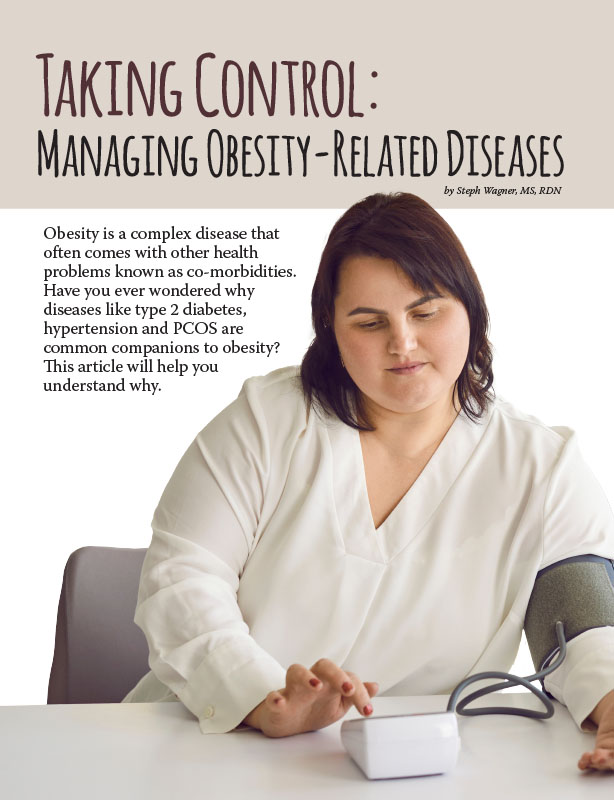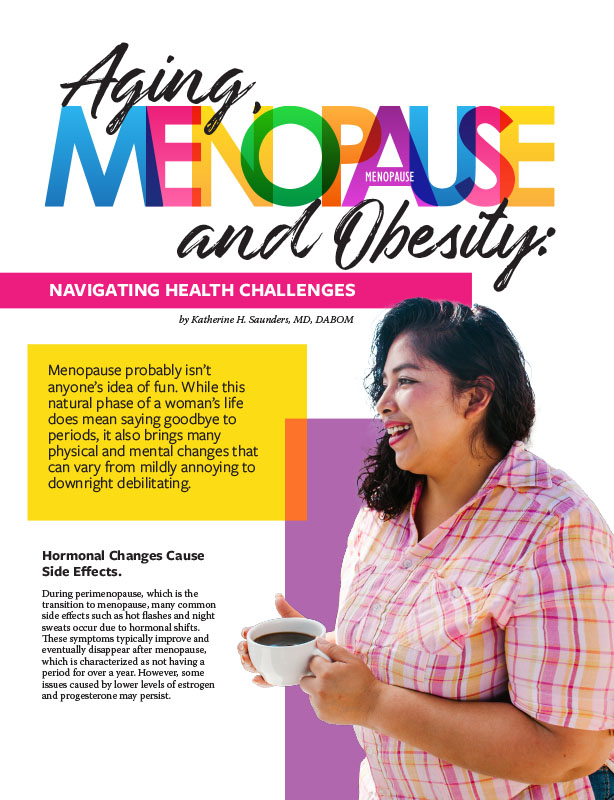Obesity and Type 2 Diabetes


by Joanne Z. Rogers, MSN, RN, CNSN, APRN, BC-AD, and Christopher D. Still, DO, FACN, FACP
Fall 2005
Obesity and type 2 diabetes are diseases that can substantially decrease life expectancy, diminish quality of life and increase healthcare costs. The incidence of obesity and diabetes continues to rise by epidemic proportions. The term “diabesity” has been coined to describe obesity-dependent diabetes.
According to the American Diabetes Association, in 2002 18.2 million people, or 6.3 percent of the population, had diabetes. Diabetes was the sixth leading cause of death listed on U.S. death certificates in 2000. The direct and indirect cost of diabetes in the U.S. in 2002 was estimated at $132 billion. It has been estimated that the annual cost of overweight and obesity in the U.S. is $122.9 billion. This estimate accounts for $64.1 billion in direct costs and $58.8 billion in indirect costs.
What is Diabetes?
Diabetes is a disease characterized by high levels of blood glucose resulting from defects in insulin production, insulin action or both. Type 1 diabetes develops when the body’s immune system destroys pancreatic beta cells, the only cells in the body that make the hormone insulin that regulates blood glucose. This form of diabetes usually strikes children and young adults, although disease onset can occur at any age.
Type 1 diabetes accounts for only five to 10 percent of all diagnosed cases of diabetes. Risk factors for type 1 diabetes include autoimmune, genetic and environmental factors.
Type 2 diabetes accounts for some 90 to 95 percent of all diagnosed cases of diabetes. It usually begins as insulin resistance, a disorder in which the cells do not use insulin properly. As the need for insulin rises, the pancreas gradually loses its ability to produce insulin.
Risk of Type 2 Diabetes
The risk of developing type 2 diabetes is determined by some factors that can be modified and others that cannot. Some people are at higher risk for developing type 2 diabetes because of their genes. A first-degree relative of a person with types 2 diabetes has a risk five to 10 times higher than a person without a family history.
Another factor that may increase the risk of type 2 diabetes is low birth weight. Intrauterine growth restriction leading to low birth weight seems to be associated with increased risk in adulthood of insulin resistance, glucose intolerance and type 2 diabetes. However, encouraging research studies in the U.S. and abroad have found that lifestyle changes, such as changes in diet and exercise, can prevent or delay the onset of type 2 diabetes among high-risk adults.
At all ages, the risk of type 2 diabetes rises with increasing body weight. The prevalence of type 2 diabetes is three to seven times higher in those who are affected by obesity than in normal weight adults, and is 20 times more likely in those with a body mass index (BMI) greater than 35 kg/m 2.
Obesity’s Role in the Development of Type 2 Diabetes
It is not known for sure why some people develop insulin resistance, but it is known that obesity and lack of physical activity make it worse. The development of insulin resistance is an important component in the development of type 2 diabetes. The connection is also seen in the fact that weight-loss can improve control or cure type 2 diabetes. In addition to the degree of obesity, where the excess body fat is deposited is important in determining the risk of type 2 diabetes.
The degree of insulin resistance and the incidence of type 2 diabetes is highest in a person with an “apple” shape. These persons carry the majority of their excess body weight around their abdomen. In contrast, the “pear” shaped person carries most of their weight in the hips and thighs and this is not as likely to be associated with insulin resistance.
Treating Obesity Will Treat Type 2 Diabetes
Weight-loss is an important goal for persons affected by excess weight or obesity, particularly those with type 2 diabetes. Moderate and sustained weight-loss (five percent to 10 percent of body weight) can improve insulin action, decrease fasting glucose concentrations and reduce the need for some diabetes medications. A program of diet, exercise and behavior modification can successfully treat obesity, but pharmacotherapy and/or surgery may be warranted.
Diet
Weight-loss occurs when energy expenditure exceeds energy intake. Creating an energy deficit of 500-1,000 calories per day will result in a one to two-pound weight-loss per week. Writing down the food, portion size and calorie amount has been found to increase awareness and will provide objective evidence of calorie intake.
For effective weight-loss, it is the calories that count, not the proportion of fat, carbohydrates or protein. However, when individuals are losing weight they should follow a diet similar to that recommended in the U.S. Dietary Guidelines for 2005: fat 20-35 percent of calories; carbohydrates 45-65 percent; protein 10-35 percent.
For the patient affected by obesity with diabetes or insulin resistance, limiting servings of complex carbohydrates may be beneficial. These foods include bread, rice, pasta, potatoes, cereal, peas and sweet potatoes. Complex carbohydrates tend to raise blood sugar more than other foods and will cause the body to produce more insulin. With insulin resistance, these increased amounts of insulin can promote weight gain.
Increasing the amount of fiber in ones diet may be beneficial for both diabetes and obesity. A high intake of dietary fiber, particularly of the soluble type, may improve glycemic control, decreases hyperinsulinemia and lower plasma lipid concentrations in patients with type 2 diabetes. Additionally, high fiber foods assist in weight-loss and long-term weight maintenance by: requiring more chewing and taking longer to eat, providing fewer calories per serving, creating a sense of abdominal fullness and enhancing fullness between meals.
Physical Activity
Regular physical activity helps maintain weight-loss and prevent regain. It also improves insulin sensitivity and glycemic control, may decrease the risk of developing diabetes and reduces mortality in patients with diabetes.
A goal should be set for 30 to 45 minutes of moderate exercise five times per week. The exercise does not need to occur in a single session to be beneficial. Dividing the activity into multiple and short episodes produces similar benefits and can enhance compliance. Using a pedometer can help set objective exercise goals. Gradually increasing the number of steps per day, with a goal of 8,000 steps, is ideal. Any increase in activity over baseline will help in balancing the equation of less calories in and more calories out to promote weight-loss.
Medication
There are several medications intended to treat diabetes, insulin resistance and obesity. A full review of these medications is beyond the scope of this article. However, metformin is one medication that has been found helpful in reducing the risk of type 2 diabetes in patients with insulin resistance. Metformin reduced the rate of progression to diabetes in persons affected by obesity with impaired glucose tolerance.
Men treated with metformin who had central obesity and other features of metabolic syndrome (insulin resistance, hypertension, hyperlipidemia) had slightly more weight-loss and slightly lower fasting blood glucoses that those given a placebo.
Bariatric Surgery
According to the National Institute of Health (NIH), bariatric surgery should be considered by those who have a BMI greater than 40, or have a BMI of 35-39.9 and medical problems such as diabetes, heart disease or sleep apnea.
Bariatric surgery changes the normal digestive process. There are three types of surgery: restrictive, malabsorptive and combined restrictive/malabsorptive. The NIH Web site provides an overview of the procedures and how they produce weight-loss.
Studies continue to show that diabetes can be cured in many patients using bariatric surgery. These clinical improvements occur not only because of the significant weight-loss, but because of hormonal changes that occur when foods bypass the stomach.
Patients and their doctors need to consider the risk of bariatric surgery compared to the risk of obesity and the associated medical problems. When other methods of weight-loss have failed, bariatric surgery may be the best chance for significant and sustained weight-loss.
Prevention
Preventing and treating obesity will help in the prevention and treatment of diabetes. Promoting a healthy lifestyle in children and adolescents will put them on a path that will decrease their risk of diabetes and its complications. Helping adults at high risk for diabetes to change their diet and lifestyle may prevent them from developing diabetes and its consequences.
About the Authors:
Joanne Rogers, MSN, RN, CNSN, APRN, BC-AD, is a Clinical Nurse Specialist in the Geisinger Health System. She has worked within the Center for Nutrition and Weight Management for the last 11 years. She is part of a multidisciplinary team that provides care to those with morbid obesity and co-morbid medical problems through the use of diet, exercise, behavior modification and/or pharmacotherapy and bariatric surgery.
Christopher Still, DO, FACN, FACP, has been studying developments in nutrition support and obesity for nearly a decade. He serves as principal investigator on a rural elderly nutrition and aging study of some 22,000 individuals. Dr. Still’s interest in weight-loss comes from his personal experiences with obesity. Dr. Still once weighed 365 pounds, and losing the weight was a life and career changing experience. He is also a charter member of the OAC National Board of Directors.
References:
- American Diabetes Association, North American Association for the Study of Obesity, American Society for Clinical Nutrition. Weight Management Using Lifestyle. Modification in the Prevention and Management of Type 2 Diabetes: Rationale and Strategies. Clinical Diabetes 23 (3): 130-136, 2005.
- National Institutes of Health, National Institute ofDiabetes, Digestive and Kidney Diseases. “Statistics Related to Overweight and Obesity: The Economic Costs.” www.niddk.nih.gov/health/nutrit/pubs/statobes.htm#econ.
- Diabetes Prevention Program Research Group, Reduction in the incidence of type 2 diabetes with lifestyle intervention or metformin. NEJM 346:393-402. 2002.
- U.S. Department of Health and Human Services. Dietary Guidelines for Americans 2005.
- U.S. Department of Health and Human Services. Gastrointestinal Surgery for Severe Obesity. https://win.niddk.nih.gov/publications/gastric.htm.
by Steph Wagner, MS, RDN Spring 2024 Obesity is a complex disease that often comes with other…
Read Articleby Katherine H. Saunders, MD, DABOM Spring 2024 Menopause probably isn’t anyone’s idea of fun. While this…
Read Articleby Sarah Ro, MD; and Young Whang, MD, PhD Fall 2023 Mary, a postmenopausal woman with a…
Read Article








